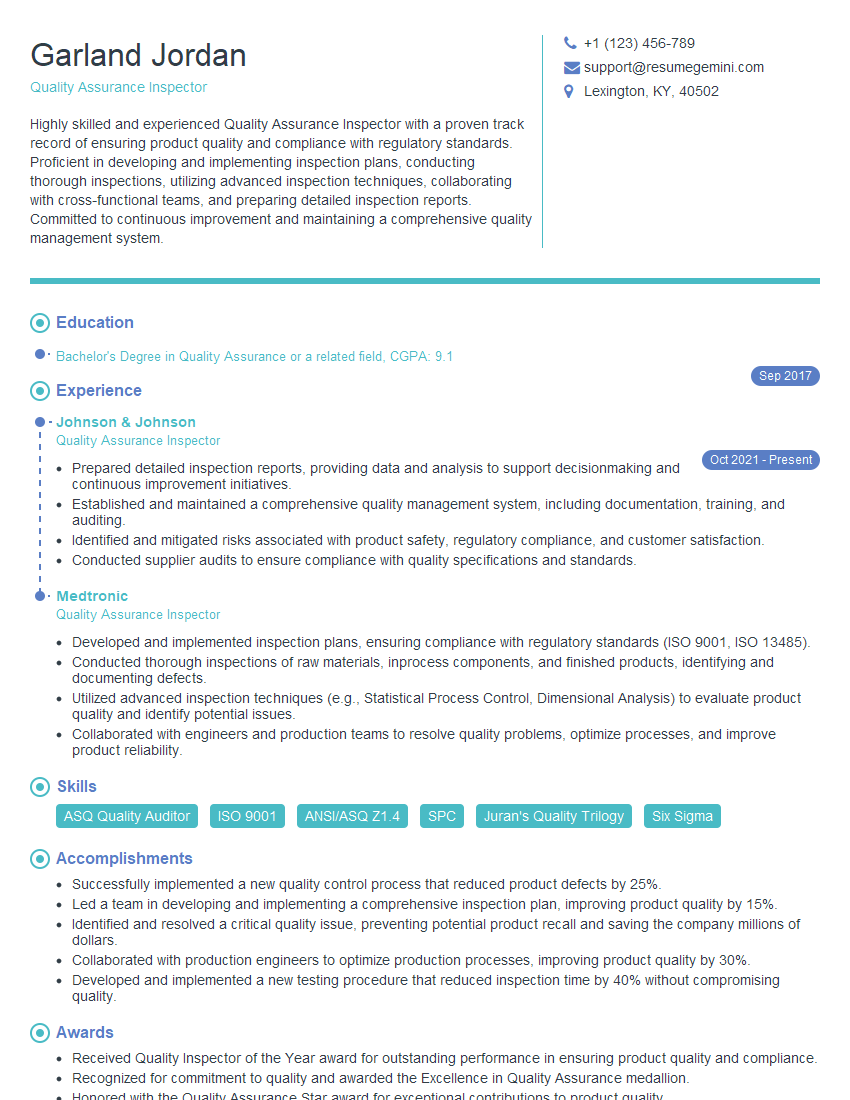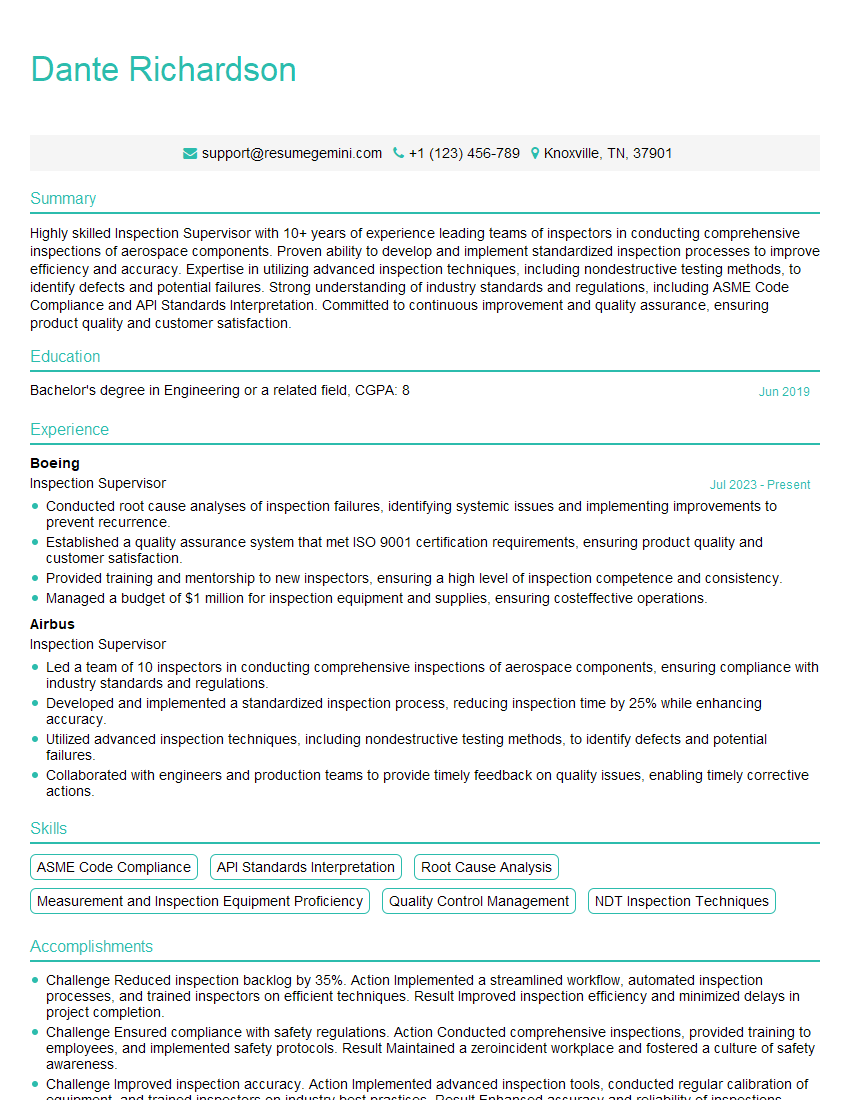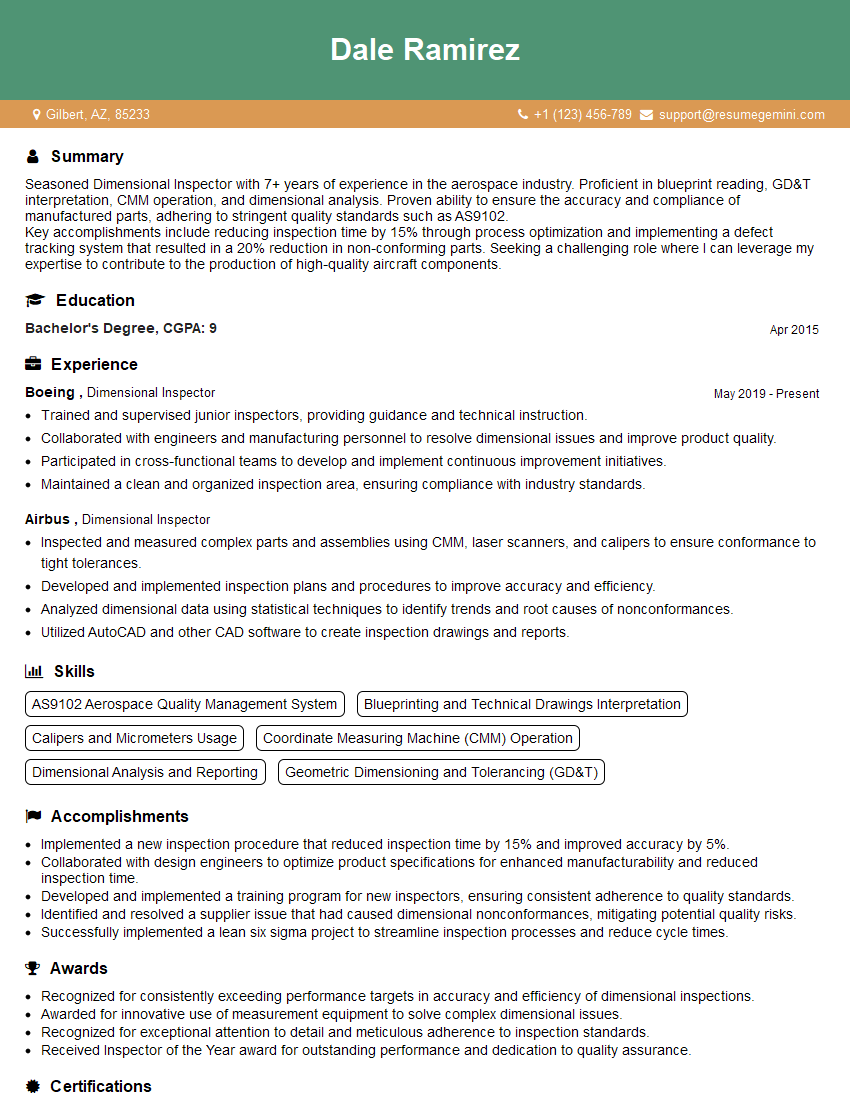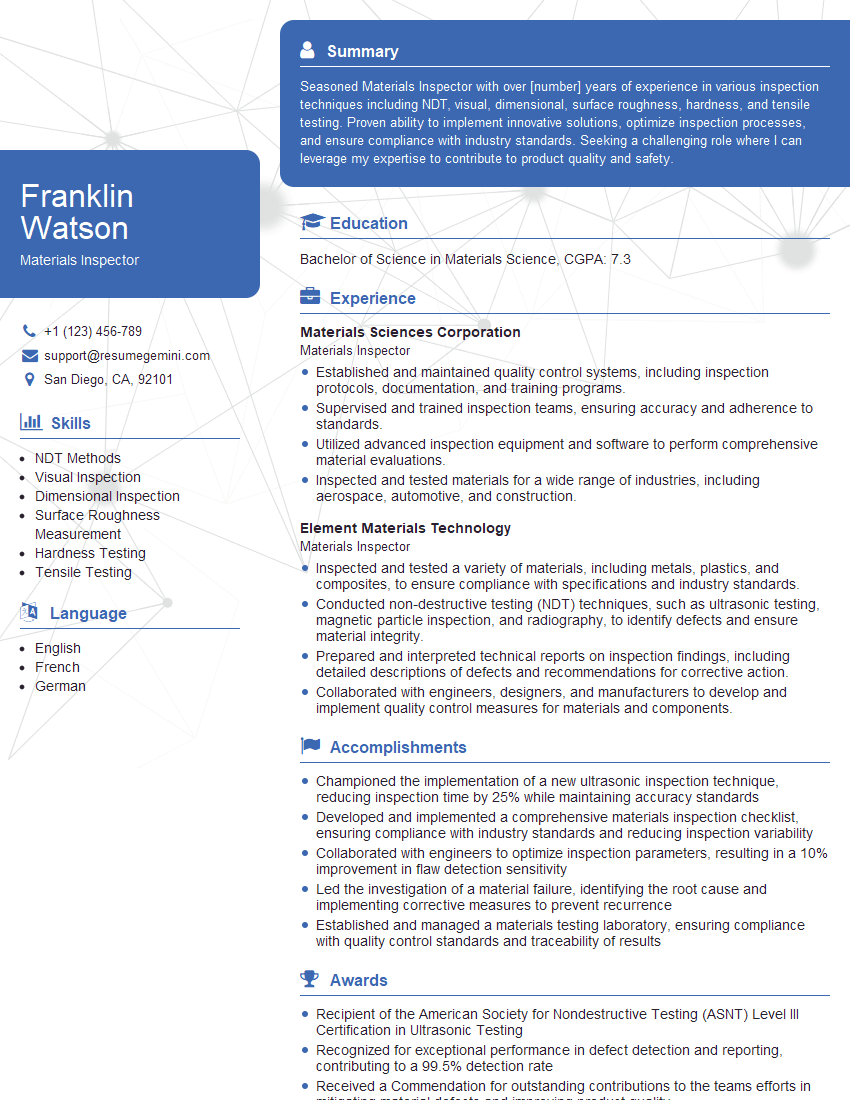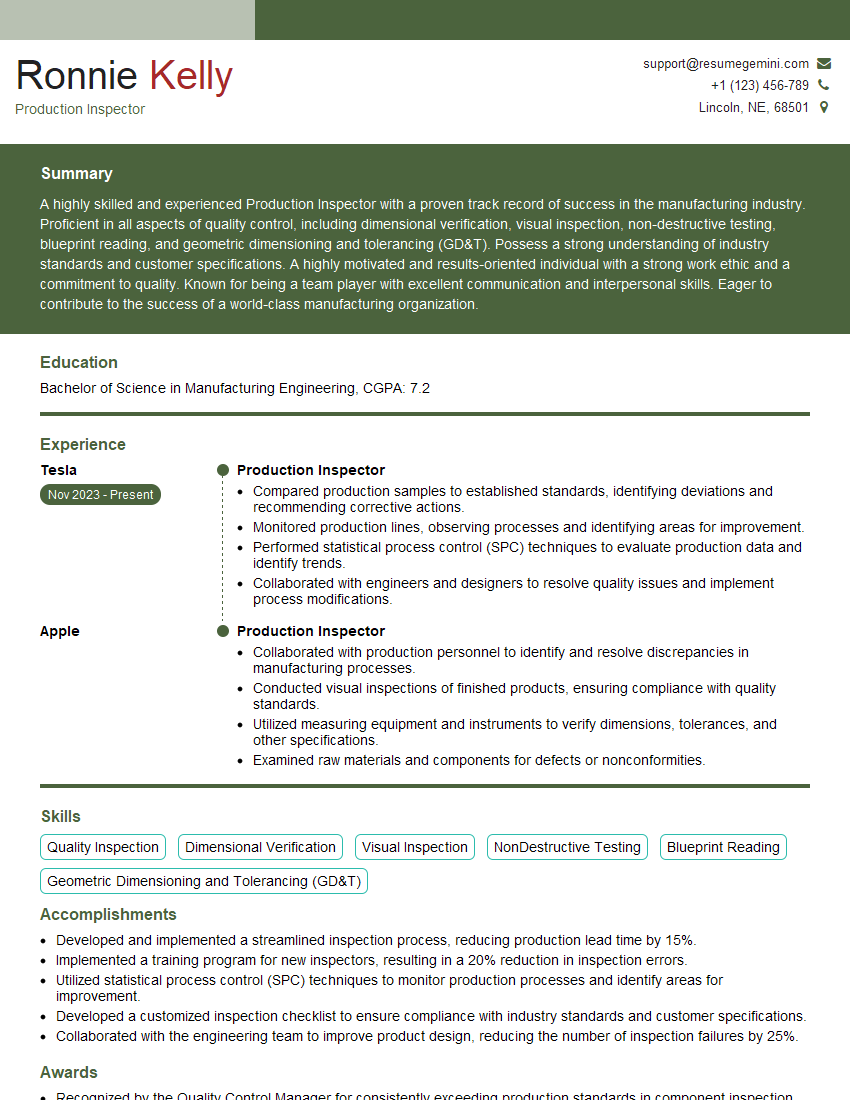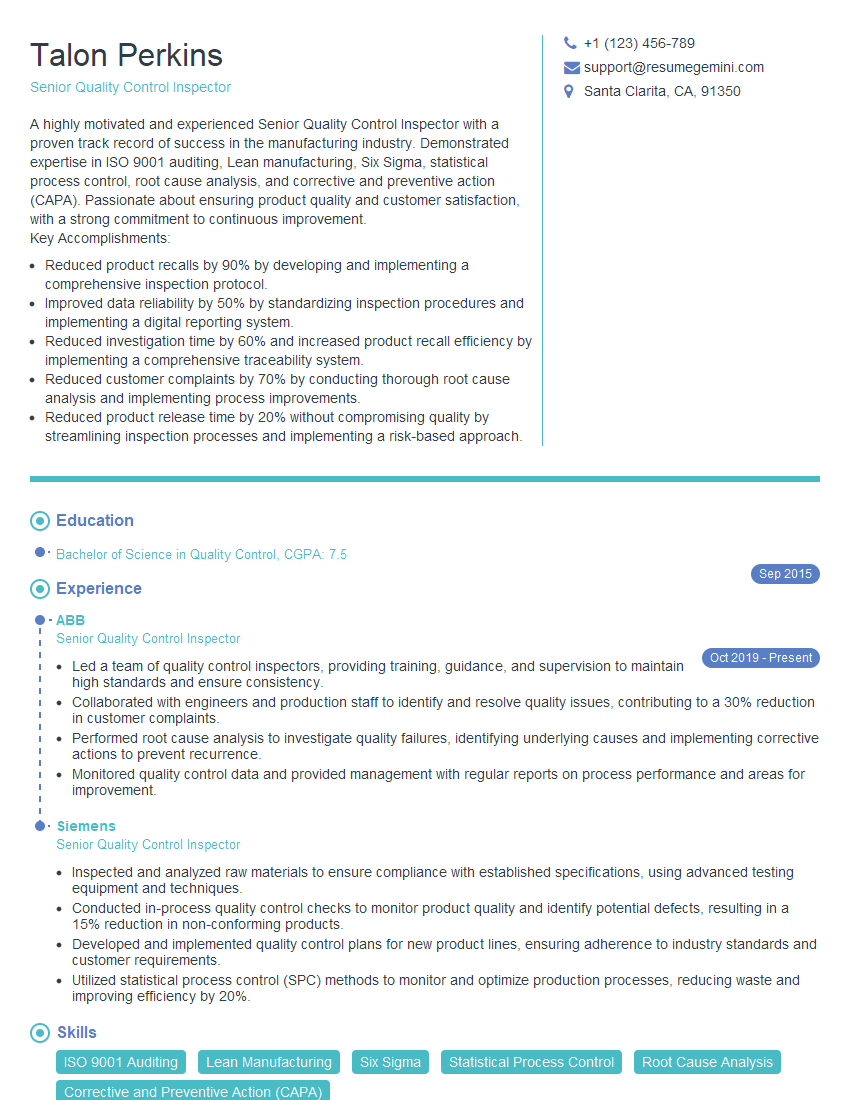Feeling uncertain about what to expect in your upcoming interview? We’ve got you covered! This blog highlights the most important Certified Bolt Thread Inspector interview questions and provides actionable advice to help you stand out as the ideal candidate. Let’s pave the way for your success.
Questions Asked in Certified Bolt Thread Inspector Interview
Q 1. Explain the different types of thread gauges and their applications.
Thread gauges are precision tools used to verify the dimensions and accuracy of screw threads. There are several types, each serving a specific purpose:
- Plug Gauges: These gauges are shaped like a screw and are used to check the minimum size of the internal thread (nut). A ‘Go’ plug gauge should pass freely through the internal thread if it’s within tolerance. A ‘No-Go’ gauge, slightly larger, should not pass. Think of it like a key fitting into a lock; the Go gauge should slip in easily, while the No-Go gauge shouldn’t.
- Ring Gauges: These are ring-shaped gauges used to inspect the maximum size of the external thread (bolt). A ‘Go’ ring gauge should freely accept the external thread, while the ‘No-Go’ ring gauge should not. It’s the reverse of the plug gauge concept – checking to make sure the bolt isn’t too big.
- Screw Pitch Gauges: These gauges aren’t used for dimensional checks, but to determine the thread pitch (distance between threads). They consist of a series of blades, each with a different pitch, allowing for quick identification of the thread’s pitch.
- Thread Micrometers: These are more precise measuring tools that use a micrometer screw to accurately measure thread diameters, pitch, and other dimensions, providing much more detailed information than plug or ring gauges. They are excellent for finer measurements and detailed analysis.
The choice of gauge depends entirely on the application. Mass production might rely on quick plug and ring gauge checks, while critical aerospace components will demand the accuracy of a thread micrometer and potentially other advanced measuring instruments.
Q 2. Describe the process for inspecting bolt threads using a thread gauge.
Inspecting bolt threads using a thread gauge is a straightforward yet crucial process. Here’s a step-by-step guide:
- Select the appropriate gauge: Choose the correct plug and ring gauge for the specific thread size and type (e.g., UNC, Metric).
- Clean the thread: Ensure the bolt and/or nut is clean and free from debris; dirt or burrs can interfere with accurate measurements.
- Insert the ‘Go’ gauge: For external threads, use the ‘Go’ ring gauge. It should easily pass over the entire length of the thread. For internal threads, use the ‘Go’ plug gauge; it should freely screw into the nut.
- Insert the ‘No-Go’ gauge: Again, for external threads, attempt to use the ‘No-Go’ ring gauge. It should *not* pass over the thread. For internal threads, attempt to screw the ‘No-Go’ plug gauge into the nut; it should not pass.
- Interpret the results: If both ‘Go’ and ‘No-Go’ gauges perform as expected, the thread is within tolerance. If the ‘No-Go’ gauge passes, the thread is too large. If the ‘Go’ gauge doesn’t pass, the thread is too small. Failure at this stage necessitates further investigation.
Remember to always follow the manufacturer’s instructions for using your specific thread gauge and safety precautions.
Q 3. How do you identify and classify common thread defects?
Identifying thread defects requires careful visual inspection and often the use of magnification. Common defects include:
- Broken or damaged threads: Threads that are chipped, stripped, or broken.
- Roughness or irregularities: Surface imperfections that affect the smoothness of the thread profile.
- Imperfect pitch or lead: Incorrect spacing or alignment of threads.
- Taper or bell mouth: Threads that are wider at the ends than in the middle.
- Incorrect thread form: Deviations from the correct thread profile, such as incorrect angle or depth.
- Corrosion or pitting: Damage to the thread surface due to corrosion.
Classification often involves assigning a severity level based on the defect’s size, location, and impact on the bolt’s functionality. For example, a minor surface scratch might be acceptable, while a major thread breakage would clearly render the bolt unusable. The standards used (ASME, ISO, etc.) often provide guidelines for acceptable defect limits.
Q 4. What are the acceptable tolerances for bolt threads according to relevant standards (e.g., ASME, ISO)?
Acceptable tolerances for bolt threads are defined in standards such as ASME B1.1 (Unified Inch Screw Threads) and ISO 68-1 (Metric Screw Threads). These standards specify allowable variations in thread dimensions, including major diameter, minor diameter, pitch diameter, and thread profile. Tolerances are expressed as plus or minus values relative to the nominal (basic) thread size. For instance, an ISO metric bolt might have a tolerance range of +0.05mm to -0.10mm on its pitch diameter. The specific tolerance depends on the grade and size of the bolt, as well as the intended application. Higher-precision applications, like aerospace, necessitate tighter tolerances compared to less demanding applications.
Finding these tolerances requires consulting the relevant standard documents or using specialized software that has the standards data built in. You cannot simply ‘guess’ or ‘estimate’; the standards are very precise and crucial to safety and reliability.
Q 5. How do you document your inspection findings?
Thorough documentation is essential in bolt thread inspection. Findings should be recorded clearly and unambiguously, including:
- Date and time of inspection: Provides traceability for auditing and historical reference.
- Bolt identification: Unique identifiers for the inspected bolts (part number, lot number, serial number, etc.).
- Gauge used: Specification of the thread gauge used (size, type, manufacturer, etc.).
- Inspection results: Clear indication of whether the threads are within or outside of tolerance. A diagram could be very useful to pinpoint the location of defects. Measurements should be recorded with units.
- Defects identified: Detailed description of any identified defects, including their location, severity level, type (e.g., broken thread, pitting), and any photographs taken. Quantifying the extent of the defect is important.
- Inspector’s signature and qualifications: Provides accountability and confirms the inspector’s competence.
A standard inspection report form or a digital database can streamline the documentation process, ensuring consistency and readability. This documentation is crucial for quality control, troubleshooting, and potential legal issues.
Q 6. Describe your experience with different types of measuring instruments used in bolt thread inspection.
Beyond thread gauges, numerous instruments are employed in advanced bolt thread inspection. My experience encompasses:
- Optical comparators: These allow detailed visual examination of thread profile, revealing subtle imperfections not readily visible to the naked eye.
- Coordinate Measuring Machines (CMMs): CMMs are very precise machines used for measuring three-dimensional geometry, capable of extremely accurate thread profile measurements.
- Scanning electron microscopes (SEMs): These provide high-magnification images, ideal for identifying minute surface defects or assessing the microstructural properties of the bolt material.
- Profile projectors: Project an enlarged image of the thread profile onto a screen, facilitating detailed analysis.
- Digital calipers and micrometers: Provide precise measurements of thread dimensions.
Selecting the appropriate instrument depends on the inspection requirements, the required level of precision, and the availability of resources. For example, a simple visual inspection might suffice for low-criticality parts, but aerospace or nuclear applications would demand the accuracy of a CMM or SEM.
Q 7. What are the implications of using incorrect thread gauges?
Using incorrect thread gauges has significant implications, potentially leading to:
- Rejection of acceptable parts: Using a gauge that’s too small could result in incorrectly rejecting good parts, leading to unnecessary waste and increased costs.
- Acceptance of faulty parts: Conversely, using a gauge that’s too large can lead to the acceptance of parts with substandard threads, posing serious safety risks in applications where the strength of the bolt is critical.
- Compromised product quality: The use of improper gauges introduces inaccuracies into the quality control process, potentially compromising the overall quality of the product.
- Safety hazards: In situations where bolts are used in safety-critical components (e.g., automotive, aerospace), using the wrong gauge can result in the use of faulty bolts, leading to catastrophic failures.
- Legal and liability issues: Using incorrect gauges can lead to product liability claims if a failure occurs due to improperly inspected parts.
Therefore, it’s crucial to always use the correct thread gauge, ensuring its proper calibration and maintenance before every inspection to guarantee accurate and reliable results.
Q 8. How do you handle discrepancies found during inspection?
Discrepancies during bolt thread inspection are handled systematically and documented meticulously. My first step is to carefully re-examine the bolt using different thread gauges and measuring tools to confirm the initial finding. Photography is crucial; I document each discrepancy with high-resolution images, clearly showing the defect’s location and nature. This ensures that I’m not making assumptions about the issue.
Next, I consult the relevant engineering drawings and specifications to verify the acceptable tolerances. If the discrepancy falls outside these tolerances, I classify it according to its severity (e.g., minor surface imperfections versus a major thread defect). A detailed report is then generated, clearly stating the identified problem, its location, the relevant specifications, and the proposed corrective action, which could range from rejecting the bolt to performing further analysis for root cause identification. Communication with the quality control manager and manufacturing personnel is crucial to initiate corrective measures and prevent future recurrences. For example, if multiple bolts from the same batch show the same defect, it indicates a problem with the manufacturing process needing immediate attention.
Q 9. Explain the importance of maintaining accurate calibration records for thread gauges.
Maintaining accurate calibration records for thread gauges is paramount for ensuring the reliability and validity of our inspection results. Without accurate calibration, our measurements are meaningless, potentially leading to the acceptance of defective bolts or the rejection of good ones – both equally costly mistakes. Think of it like this: a miscalibrated scale would weigh your groceries incorrectly, similarly, an improperly calibrated gauge would lead to inaccurate assessment of the bolts’ threads.
We maintain a detailed log for each gauge, noting the date of calibration, the results of the calibration, the name of the calibrating technician, and the next scheduled calibration date. This log is reviewed regularly, and the gauges are sent to a certified calibration laboratory for periodic checks. Calibration certificates are filed with the records, providing a complete audit trail. Any deviation from the established calibration standards results in the immediate removal of the affected gauge from service until it’s recalibrated and its accuracy is verified.
Q 10. How do you ensure the integrity of your inspection process?
The integrity of our inspection process is maintained through a multi-pronged approach. Firstly, we use a combination of both go/no-go gauges and precision measuring equipment (micrometers, comparators) to ensure comprehensive testing. We use multiple gauges to check different aspects like thread pitch, major diameter, minor diameter, and thread form. Using multiple tools and techniques minimizes the possibility of errors.
Secondly, we employ rigorous statistical process control techniques to monitor the inspection data. This helps us identify trends and potential issues before they escalate into widespread problems. Regular internal audits are conducted to evaluate our compliance with established procedures and standards. Each inspector is qualified, and we follow a strict chain of custody for all inspected parts, ensuring traceability throughout the process. Finally, we regularly participate in proficiency testing programs to validate the competency of our inspectors and the effectiveness of our methodologies.
Q 11. Describe your experience with different types of bolt materials and their impact on inspection.
Experience with diverse bolt materials significantly impacts the inspection process. The material properties directly influence the thread’s characteristics and its susceptibility to defects. For instance, stainless steel bolts can be prone to galling (adhesion of the mating threads), requiring a more careful inspection for signs of seizure or damage. Similarly, inspecting high-strength steel bolts requires greater precision as the allowable tolerances are usually tighter. High-temperature alloys present unique challenges, as the heat treatments can subtly affect the thread geometry.
My experience includes working with various materials, including carbon steel, stainless steel (304, 316), alloy steels, and titanium. Each material requires specific knowledge of its mechanical properties, its responses to various manufacturing processes, and the types of defects specific to it. For example, during the inspection of a titanium bolt, we would be particularly vigilant about signs of cracks, which are more common in titanium compared to other materials. Our inspection procedures adapt to the unique characteristics of each material to ensure thorough and accurate assessment.
Q 12. How do you interpret engineering drawings related to bolt thread specifications?
Interpreting engineering drawings related to bolt thread specifications is a core competency for a Certified Bolt Thread Inspector. We need to be proficient in reading and understanding various standards and notations on engineering drawings such as ANSI, ISO, and DIN standards. These drawings provide crucial details including the nominal diameter, thread pitch, thread form (e.g., Unified, Metric), tolerance limits, class of fit, and material specifications. The level of precision required is dictated by the application of the bolt. For instance, a bolt for critical aerospace applications will have far tighter tolerance requirements than one in a less critical application.
I begin by carefully reviewing the drawing for all relevant specifications. I then use these specifications to select the appropriate thread gauges and measuring tools for the inspection. The class of fit dictates the type of gauge required (e.g., for a tighter fit, more precision tools are needed). If there are any ambiguities or inconsistencies, I seek clarification from the engineering team to ensure accuracy and consistency.
Q 13. What are the common causes of thread damage or defects?
Common causes of thread damage or defects can be categorized into those arising during the manufacturing process and those occurring during handling or usage. Manufacturing defects include issues with the die or tap used in the threading process, leading to irregularities like incomplete threads, burrs, or variations in pitch. Improper heat treatment can also affect the strength and integrity of the thread.
Damage during handling or usage can result from improper installation, such as cross-threading or over-tightening. Corrosion, either through exposure to harsh environmental conditions or inadequate surface treatment, can also lead to thread degradation. Furthermore, damage can arise from mechanical impacts or vibrations during the service life of the bolt. For example, a bolt subjected to repeated high stress might suffer from fatigue, eventually resulting in crack formation.
Q 14. How do you prioritize your inspection tasks to ensure efficient workflow?
Prioritizing inspection tasks is crucial for efficient workflow. My approach involves a combination of factors. Firstly, I prioritize critical components and parts for critical applications. Bolts that are essential for safety and reliability of the final product, or those with tighter tolerances and higher stakes are handled first. This ensures that the most critical parts are inspected promptly.
Secondly, I group similar parts to optimize the inspection process. This allows for a more efficient workflow by allowing me to use the same gauges and measuring tools for similar parts. Finally, I utilize batch processing where possible. This reduces the setup time and improves the overall inspection efficiency. The use of computerized inspection systems and software helps with organizing and tracking inspection tasks, adding further efficiency.
Q 15. Describe a situation where you had to troubleshoot a challenging thread inspection problem.
One particularly challenging situation involved inspecting a batch of high-strength steel bolts destined for a critical aerospace application. Initial inspection using a conventional thread gauge revealed inconsistencies – some threads showed minor deviations from the specified tolerance. However, the deviations were subtle and borderline, making it difficult to definitively classify them as acceptable or rejectable.
To troubleshoot, I employed a three-pronged approach: First, I used a digital thread micrometer for more precise measurements, collecting data points across multiple threads on several samples. This provided quantitative data to supplement the visual inspection. Second, I reviewed the manufacturing process documentation, looking for potential sources of variation like inconsistencies in the die or machining parameters. Third, I consulted the relevant aerospace standard (e.g., AS9100) to gain clarity on the acceptance criteria and potential tolerances for borderline cases. This systematic approach allowed us to pinpoint the root cause (minor variations in the die) and implement corrective actions, preventing potentially disastrous consequences.
Career Expert Tips:
- Ace those interviews! Prepare effectively by reviewing the Top 50 Most Common Interview Questions on ResumeGemini.
- Navigate your job search with confidence! Explore a wide range of Career Tips on ResumeGemini. Learn about common challenges and recommendations to overcome them.
- Craft the perfect resume! Master the Art of Resume Writing with ResumeGemini’s guide. Showcase your unique qualifications and achievements effectively.
- Don’t miss out on holiday savings! Build your dream resume with ResumeGemini’s ATS optimized templates.
Q 16. What safety precautions do you follow during bolt thread inspection?
Safety is paramount in bolt thread inspection. My safety precautions consistently include:
- Eye protection: Always wearing safety glasses to prevent injury from flying debris during gauging or handling.
- Hand protection: Using gloves to protect my hands from sharp edges and potential contaminants on the bolts.
- Proper handling of tools: Carefully handling and storing inspection tools to prevent damage and injury. This includes maintaining calibration records and using tools only for their intended purpose.
- Work environment: Ensuring a well-lit and organized workspace minimizes risks of trips, falls, and collisions.
- Following company safety protocols: Strict adherence to all company-specific safety guidelines and procedures.
Q 17. What are your preferred methods for communicating inspection results?
Effective communication of inspection results is crucial. My preferred methods include:
- Detailed inspection reports: Generating comprehensive reports outlining the inspection method, sample size, specific measurements, any deviations from specifications, and clear pass/fail assessments. These reports include photographic evidence where necessary.
- Clear visual aids: Using clear charts, graphs, and images to present data effectively, especially when dealing with large datasets or complex deviations.
- Verbal briefing: Providing a concise verbal summary of the inspection results to the relevant stakeholders, ensuring a thorough understanding of the findings and their implications.
- Data-driven communication: Using statistical process control (SPC) charts to highlight trends and potential problems for proactive action.
The choice of method depends on the audience and the complexity of the findings. For example, a detailed written report would be essential for a formal audit, while a concise verbal briefing might suffice for a quick update to the production team.
Q 18. Explain your understanding of statistical process control (SPC) in the context of bolt thread inspection.
Statistical Process Control (SPC) is invaluable in bolt thread inspection. It allows us to monitor the consistency of the manufacturing process over time, identifying potential problems before they lead to widespread defects. In the context of bolt thread inspection, I use SPC by collecting data points on key characteristics like thread pitch, major and minor diameters, and thread profile during regular intervals.
This data is then plotted on control charts (e.g., X-bar and R charts, or individual and moving range charts) to monitor the process mean and variability. Out-of-control signals (points outside control limits, runs, or trends) indicate potential process shifts or problems requiring investigation. For example, a sudden increase in the variation of thread pitch diameter might indicate a worn-out die. By proactively addressing these signals, we can prevent producing batches of non-conforming bolts, reducing waste and ensuring consistent product quality. This data supports evidence-based decision-making, leading to process improvements and cost savings.
Q 19. How do you stay current with the latest standards and best practices in bolt thread inspection?
Staying current is vital in this field. I actively engage in several strategies:
- Professional organizations: I actively participate in relevant professional organizations like ASME (American Society of Mechanical Engineers) or similar organizations, attending conferences and webinars to learn about the latest standards, best practices, and technological advancements.
- Industry publications: I subscribe to and regularly read industry-specific journals and publications to keep abreast of the latest research and developments.
- Training courses: I regularly participate in updated training courses focused on advanced inspection techniques, new standards, and improved measurement technologies.
- Networking: I actively network with other professionals in the field to exchange knowledge and stay updated on industry trends.
Q 20. What is your experience with different types of bolt thread profiles (e.g., metric, unified)?
My experience encompasses various bolt thread profiles, including:
- Metric threads: ISO metric threads are commonly used internationally, and I’m proficient in inspecting their various classes and sizes, including fine and coarse threads. I have experience with various associated standards, including ISO 68-1.
- Unified National Coarse (UNC) and Fine (UNF) threads: These are standard in the United States and I’m highly familiar with their specifications, including the various classes of fit.
- Other thread forms: My experience also includes encountering less common thread forms like Whitworth and Acme threads, requiring appropriate gauging and inspection techniques based on their specific characteristics.
My proficiency extends to understanding the subtle differences in each profile, enabling accurate inspection and appropriate classification based on the applicable standard.
Q 21. How do you handle situations where the inspection results are inconclusive?
Inconclusive results require a methodical approach. My strategy focuses on:
- Re-inspection: The first step is to carefully re-inspect the bolt using different tools or methods. This helps rule out operator error and confirms the initial findings.
- Collaboration with experts: Involving other experienced inspectors or metrologists for a second opinion is crucial. They might provide fresh insights or identify subtle details that I may have overlooked.
- Advanced measurement techniques: If re-inspection yields inconclusive results, utilizing more advanced measurement equipment such as coordinate measuring machines (CMMs) or optical comparators might provide the needed clarity.
- Root cause analysis: If a batch of bolts produces consistently inconclusive results, I investigate the manufacturing process for potential contributing factors, like die wear or inconsistent material properties.
- Escalation: In cases where the problem remains unsolved despite the above steps, I’d escalate the issue to management for further investigation and potential corrective actions. Documentation throughout the process is key.
Q 22. Describe your experience with using optical comparators or microscopes for thread inspection.
Optical comparators and microscopes are invaluable tools for detailed thread inspection. They allow for precise measurement and visualization of thread profile, pitch, and other critical parameters. My experience involves using both types of equipment extensively. With optical comparators, I’ve projected magnified images of the bolt thread onto a screen, comparing it to a master profile to assess conformity. This method is particularly useful for detecting subtle flaws like irregularities in the thread form or damage. Microscopes, on the other hand, offer even greater magnification, enabling detection of microscopic imperfections such as burrs or surface flaws. I’m proficient in using both shadow and profile projection techniques, selecting the appropriate method based on the specific requirements of the inspection and the type of bolt being examined.
For instance, during a recent inspection of high-strength aircraft bolts, the microscope proved critical in identifying minute cracks near the thread root, which could have compromised the structural integrity of the component. This wouldn’t have been easily detectable with a comparator alone.
Q 23. What are the limitations of using thread gauges for inspection?
While thread gauges provide a quick and straightforward ‘go/no-go’ assessment of thread fit, they have limitations. They only check for major and minor diameters and don’t provide detailed information on the thread profile itself. Subtle imperfections in the thread form, such as minor variations in flank angle or pitch, might not be detected by a gauge. Also, gauges can wear over time, leading to inaccurate measurements. Furthermore, they cannot assess thread damage like nicks or burrs, requiring supplementary visual inspection methods. Finally, specialized gauges are needed for different thread types and sizes, representing an investment in tooling.
Think of it like checking a door’s size with a template: it tells you if it fits in the frame, but not if the door is warped or damaged.
Q 24. Explain the difference between functional and visual thread inspection.
Functional thread inspection focuses on the ability of the thread to perform its intended function—to mate properly with a corresponding nut or component. It primarily involves using gauges to ensure that the major and minor diameters are within tolerance, allowing for proper engagement. Visual inspection, conversely, examines the thread’s physical characteristics, such as the thread profile, surface finish, and the presence of any defects like cracks, burrs, or wear. This often uses optical comparators or microscopes.
For example, a functional inspection might pass a bolt that’s slightly undersized but still functions correctly, while a visual inspection might fail that same bolt due to visible surface defects that could compromise long-term strength.
Q 25. How do you handle non-conforming bolts?
Handling non-conforming bolts requires a systematic approach. First, I meticulously document the non-conformity, including the specific defect(s), location, and associated bolt identification. Detailed photographs and measurements are taken. The severity of the defect is evaluated according to the relevant standards, such as those outlined in ASME or ISO. Next, the bolt is segregated from conforming parts, preventing its accidental use. The non-conforming bolt’s disposition is determined based on its severity and the customer’s requirements. Options include repair (if feasible and economically viable), scrap, or rework if possible. All actions taken are recorded and reported to the relevant personnel and the customer. Throughout the process, rigorous adherence to quality management systems is maintained.
This careful process ensures both product quality and compliance with regulatory requirements.
Q 26. Describe your understanding of root diameter and pitch diameter in relation to bolt thread inspection.
Root diameter and pitch diameter are crucial parameters in bolt thread inspection. The root diameter is the smallest diameter of the thread, measured at the base of the thread profile. The pitch diameter is the theoretical diameter such that the area of the material between the threads equals the area of the thread itself. These dimensions directly relate to the bolt’s tensile strength and its ability to effectively engage with a mating nut. An out-of-tolerance root diameter indicates a weakened bolt, while an incorrect pitch diameter can lead to poor engagement or stripping. Measurement of these diameters is crucial for verifying the quality and functional integrity of the bolt, often performed using tools like optical comparators or specialized thread measuring equipment.
Imagine trying to tighten a screw with a mismatched hole; the pitch diameter directly affects the ‘fit’ between the bolt and nut. Similarly, the root diameter’s integrity determines how much stress the bolt can handle.
Q 27. How do you manage your time effectively during a high-volume inspection?
Efficient time management during high-volume inspection is paramount. My approach involves a combination of strategies. First, I prioritize the inspection tasks based on urgency and criticality of the parts being inspected. I then meticulously plan the inspection sequence to minimize downtime. Effective use of automated measuring equipment, when applicable, drastically accelerates the process. Finally, maintaining a clean and organized workspace reduces time wasted searching for tools or parts. Regular breaks and maintaining consistent focus also prevent errors and fatigue. I regularly review my progress and adjust my approach as needed to optimize efficiency without compromising quality.
The key is to optimize workflow and prevent bottlenecks using a methodical approach.
Q 28. What software or tools are you familiar with that support thread inspection and data management?
I’m familiar with several software and tools supporting thread inspection and data management. I have experience using coordinate measuring machine (CMM) software for capturing high-precision thread measurements. The software often includes automated reporting features. I am also experienced with statistical process control (SPC) software, utilized for tracking and analyzing inspection data to monitor process capability and identify potential quality issues. Furthermore, database software helps in managing large amounts of inspection data, allowing for efficient retrieval and analysis of results. This combination ensures both precise measurements and efficient data management for better quality control.
These tools allow not just for measurement, but for proactive quality monitoring and process improvement.
Key Topics to Learn for Certified Bolt Thread Inspector Interview
- Bolt Thread Standards and Specifications: Understanding various thread profiles (e.g., Unified, Metric), classes of fit, and tolerance limits is crucial. Be prepared to discuss the implications of deviations from these standards.
- Inspection Techniques and Tools: Mastering the use of gauges, micrometers, calipers, and other inspection tools is essential for accurate measurements and defect identification. Practice describing your methodology for different inspection scenarios.
- Thread Defects and their Causes: Familiarize yourself with common thread defects (e.g., galling, stripping, cross-threading) and their root causes. Be prepared to explain how to identify and document these defects effectively.
- Material Properties and their Influence on Threads: Understand how different materials (e.g., steel, aluminum) affect thread strength, durability, and susceptibility to damage. Consider how material selection impacts inspection procedures.
- Documentation and Reporting: Practice creating clear, concise, and accurate inspection reports. This includes accurately recording measurements, defects, and relevant contextual information.
- Quality Control Procedures and Standards: Familiarity with relevant quality control methodologies (e.g., ISO 9001) and their application to bolt thread inspection will demonstrate a comprehensive understanding of the field.
- Problem-solving and Troubleshooting: Be ready to discuss scenarios where you’ve had to troubleshoot issues related to bolt thread quality. Highlight your analytical skills and ability to identify and solve problems efficiently.
Next Steps
Mastering the Certified Bolt Thread Inspector skillset opens doors to exciting career opportunities in manufacturing, quality control, and engineering. A strong resume is your key to unlocking these opportunities. Creating an ATS-friendly resume that highlights your skills and experience is vital. We recommend using ResumeGemini, a trusted resource, to build a professional and impactful resume. ResumeGemini provides examples of resumes tailored specifically for Certified Bolt Thread Inspectors to guide you through the process. Invest time in building a strong resume – it’s an investment in your future.
Explore more articles
Users Rating of Our Blogs
Share Your Experience
We value your feedback! Please rate our content and share your thoughts (optional).
What Readers Say About Our Blog
Hello,
We found issues with your domain’s email setup that may be sending your messages to spam or blocking them completely. InboxShield Mini shows you how to fix it in minutes — no tech skills required.
Scan your domain now for details: https://inboxshield-mini.com/
— Adam @ InboxShield Mini
Reply STOP to unsubscribe
Hi, are you owner of interviewgemini.com? What if I told you I could help you find extra time in your schedule, reconnect with leads you didn’t even realize you missed, and bring in more “I want to work with you” conversations, without increasing your ad spend or hiring a full-time employee?
All with a flexible, budget-friendly service that could easily pay for itself. Sounds good?
Would it be nice to jump on a quick 10-minute call so I can show you exactly how we make this work?
Best,
Hapei
Marketing Director
Hey, I know you’re the owner of interviewgemini.com. I’ll be quick.
Fundraising for your business is tough and time-consuming. We make it easier by guaranteeing two private investor meetings each month, for six months. No demos, no pitch events – just direct introductions to active investors matched to your startup.
If youR17;re raising, this could help you build real momentum. Want me to send more info?
Hi, I represent an SEO company that specialises in getting you AI citations and higher rankings on Google. I’d like to offer you a 100% free SEO audit for your website. Would you be interested?
Hi, I represent an SEO company that specialises in getting you AI citations and higher rankings on Google. I’d like to offer you a 100% free SEO audit for your website. Would you be interested?
good


